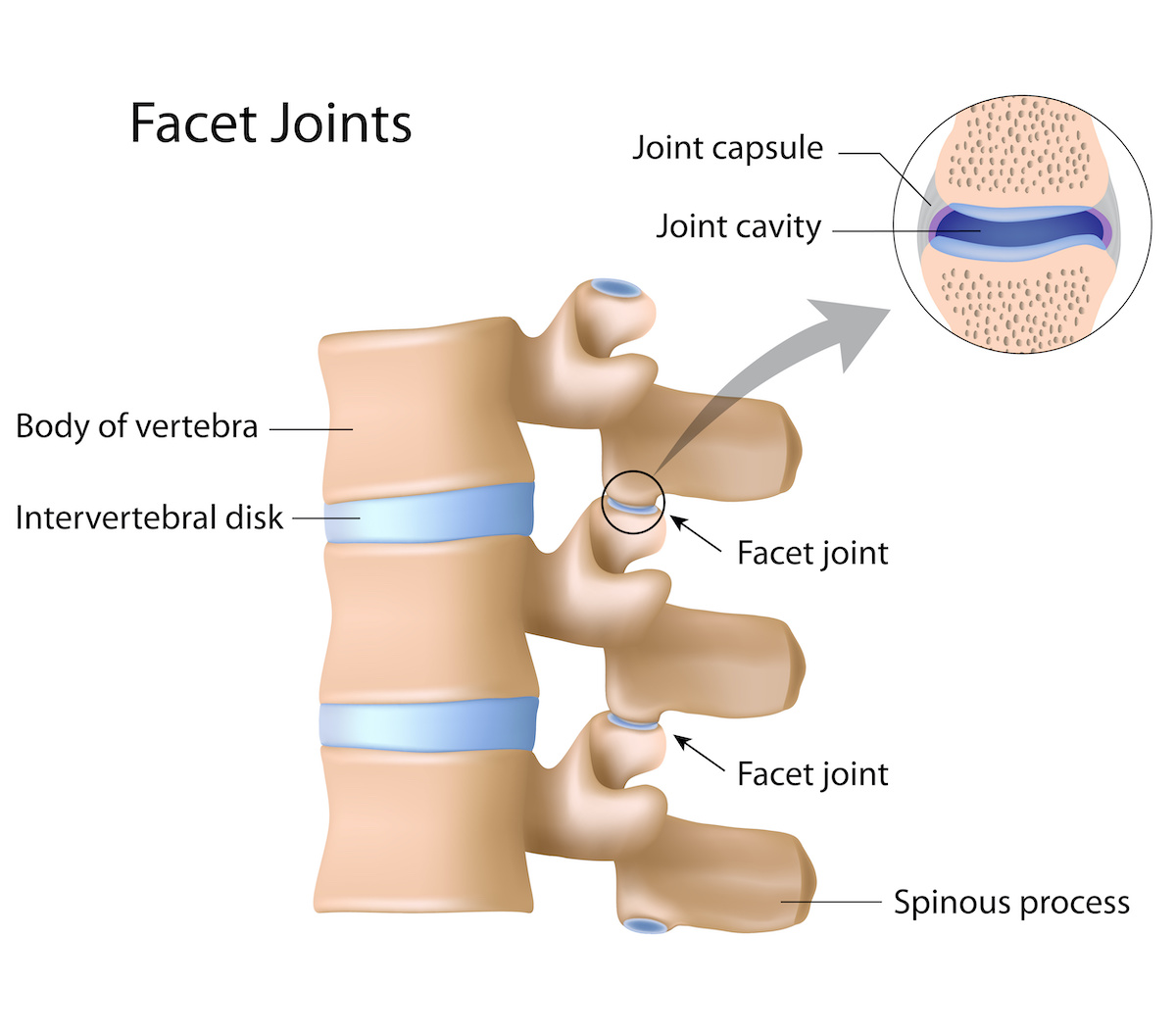
Millions of Americans experience some sort of back pain every year. One common cause of back pain is osteoarthritis (OA), also known as wear and tear arthritis or degenerative joint disease. According to the CDC, OA affects over 30 million adults in the US. Osteoarthritis can affect any joint in the body, including the facet joints in your spine. If you’re having back pain and think OA may be to blame, check out these facts about facet joints.
1. Facet Joints are a Crucial Part of Spinal Anatomy
Your spine is made up of multiple parts, all of which need to work together to keep you moving without pain or difficulty.
- Vertebral bodies/vertebrae: The small bones that are stacked on top of each other and create the structure of the back. The vertebrae create the natural curves of the back.
- Spinal cord: Extends from the skull to the lower back and travels through the middle part of each stacked vertebra, which makes up the central canal. Nerves branch out from the spinal cord through the openings between the vertebrae to transmit messages between the brain and the rest of the body.
- Muscles and ligaments: These tissues provide support for the spine and upper body. Muscles and ligaments also provide stability, with strong ligaments connecting the vertebrae to keep the spinal column in position.
- Facet joints: Small joints located between and behind each vertebra, running the entire length of the spine. These joints provide stability in the spine. These joints have a cartilage surface like other joints in the musculoskeletal system. Sometimes facet joints develop arthritis and cause back or neck pain.
- Intervertebral discs: Cushions located between each vertebral body that absorb shock and stress during movement. They prevent the vertebrae from grinding together and pushing into spinal nerves. Intervertebral discs are made up of two parts:
- Nucleus pulposus: The squishy middle of the disk that is made up of jelly-like material and makes the disc flexible.
- Annulus fibrosus: A flexible ring similar to layers of rubber bands that make up the outside of the disk.
2. Symptoms of Facet Joint Disease May Have Other Causes
Facet joint disease has many symptoms that are also caused by a herniated disc, fracture, torn muscle, or deep infection. If you have any of the following symptoms, consult a doctor to determine what is causing them.
- Pain that goes from the neck to the shoulders
- Tenderness in certain areas of the spine
- Lower back pain that radiates into the buttocks or upper thighs.
- Pain is often described as throbbing
Symptoms are also affected by the location of the damaged facet joints. A damaged joint in the cervical spine will cause symptoms in the neck and shoulders. Degenerated joints in the lumbar spine will cause symptoms in the lower back, buttocks, and thighs.
3. Facet Joint Disease Usually Develops with Age
Facet disease is usually the result of wear and tear over a person’s lifetime, similar to other kinds of osteoarthritis. However, some people develop facet joint disease due to other factors, including:
- Spondylolisthesis
- Excess weight or obesity
- Malnutrition
- Traumatic injuries from high impact sports, falls, or automobile accidents
- Smoking
- Lack of physical activity
4. There are Surgical and Non-Surgical Treatments
Treatment options vary depending on the severity of symptoms and the amount of degeneration in the joint. Most cases can be treated with non-surgical options, including:
- Using correct posture to keep your spine in alignment can prevent painful symptoms. Pay attention to your positions sitting, standing, and lying down. You may have to change your sleeping habits.
- Losing weight can alleviate strain on the joints.
- Physical therapy exercises can help with pain from facet joint disease. Physical therapists provide instruction on the correct ways to walk and lift things. Therapy may include stretches and strengthening muscles in the lower back, legs, and abdominal muscles. This treatment only works if patients do work on a regular basis.
- Steroid injections: A corticosteroid and a pain-relieving medication are injected directly into the joint that is causing pain. Relief from injections may last days or it could last years. This procedure can be repeated if necessary.
- Oral anti-inflammatory medications can be used to relieve pain. Muscle relaxers or topical creams and patches are also used in certain cases.
- Nerve radiofrequency ablation can be performed if repeated steroid injections are not effective for long periods. This procedure uses an electrode to destroy nerve fibers causing pain in facet joints.
In cases where other measures do not provide relief, spinal fusion surgery may be recommended.
If you have been diagnosed with a back condition, including one involving your facet joints, then consider getting a second opinion before committing to a treatment plan. Dr. Saint-Louis of SpineRad can give patients a comprehensive second opinion using their existing imaging scans. He will use his years of expertise in radiology to read the images and provide you with a detailed report on your diagnosis. Patients can get a second opinion from Dr. Saint-Louis online without having to leave the comfort of their homes. Contact Dr. Sain-Louis at SpineRad today to get started.